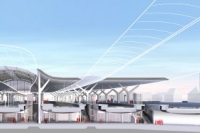Reconstruction of the
Salzburg Main Railway Station
Client: Austrian Railways Infrastructure Construction AG
Development Period: since 2006
The main railway station of Salzburg is situated on the Danube axis (Budapest - Vienna - Salzburg - München - Paris) and at the start of the Tauern axis (Salzburg - Villach - Triest) and therefore marks an important junction point in the European railway network. Concurrently, it represents the central node of the regional public traffic.
The current station with eight dead-end platforms, three through platforms and a dissatisfactory access situation for passengers no longer meets modern day requirements. Therefore, the station will be thoroughly remodelled.
For this purpose, all of the rails and platforms, the Nelböck viaduct and two more crossing objects will be rebuilt. Furthermore, a spacious central passage with an opening to the Schallmoos district is planned. Lastly, a historic hall over the platforms is heritage-protected and has to be preserved.
For this project, BGG Consult is responsible for all geotechnical and hydrogeological activities. By using the results of previous subsoil exploration campaigns (conducted in 1990 and 1993), a further investigation was conducted in 2007 for the new project. Based on these findings, a geotechnical and hydrogeological expert's report was compiled, which was needed for the construction permit application.
In 2008, expert’s reports for the different contract sections of the project were compiled.
For the sections under construction, a geotechnical and hydrogeological supervision is provided.
Deep-seated foundation:
The underground in the station area, which is on the foundation level, consists of "Seeton", a fine grained lacustrine sediment with a low bearing capacity and a high settlement sensitivity. This soil reaches to great depths. In cooperation with the designers, a foundation consisting of grouted driven steel piles and shallow grounding was chosen where heavy loads occurred. This foundation method constitutes a proper and economic option to bored cast-in-place piles.
Dewatering and ground water communication:
BGG Consult provided hydrogeology consulting for the planning of the numerous dewatering measures that are needed for the construction of the bridges. Furthermore, the planning had to ensure that remaining sheetpile walls and jet grouting bodies will not influence the natural ground water flow significantly.
May 2008
